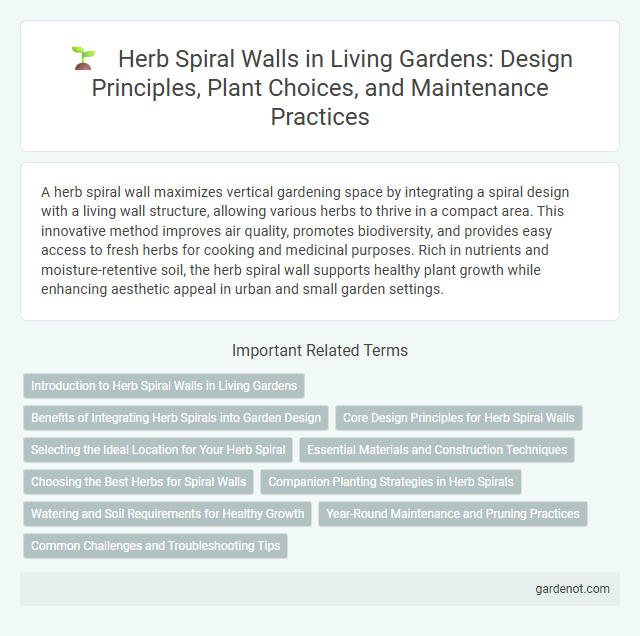A herb spiral wall maximizes vertical gardening space by integrating a spiral design with a living wall structure, allowing various herbs to thrive in a compact area. This innovative method improves air quality, promotes biodiversity, and provides easy access to fresh herbs for cooking and medicinal purposes. Rich in nutrients and moisture-retentive soil, the herb spiral wall supports healthy plant growth while enhancing aesthetic appeal in urban and small garden settings.
Introduction to Herb Spiral Walls in Living Gardens
Herb spiral walls in living gardens maximize vertical space by combining functional design with aesthetic appeal, creating a microclimate that supports diverse herb growth. These spiraling structures promote efficient water drainage and sun exposure, enhancing plant health and yield. Integrating herb spiral walls encourages sustainable gardening by increasing biodiversity and facilitating easy access to fresh herbs.
Benefits of Integrating Herb Spirals into Garden Design
Integrating herb spirals into garden design maximizes vertical space, allowing gardeners to grow diverse herbs in compact areas while enhancing aesthetic appeal. The spiral structure promotes microclimates for herbs with varying water and sunlight needs, improving plant health and yield. This efficient design supports biodiversity and easy access for harvesting, making garden maintenance more sustainable and enjoyable.
Core Design Principles for Herb Spiral Walls
Herb spiral walls maximize vertical space by combining curved structures with layered planting zones, promoting microclimates favorable for diverse herb growth. Incorporating well-draining soil and strategic sun exposure ensures each herb receives optimal moisture and light conditions. Structural integrity relies on using durable materials and anchor points to support the spiral's weight while facilitating easy access for maintenance and harvesting.
Selecting the Ideal Location for Your Herb Spiral
Choosing the ideal location for your herb spiral involves prioritizing sunlight exposure, as most herbs require at least six hours of direct sunlight daily for optimal growth. Ensure the site has well-draining soil or the ability to install proper drainage to prevent waterlogging and root rot. Accessibility for regular maintenance and harvesting should also be considered to encourage a thriving, productive herb spiral wall.
Essential Materials and Construction Techniques
Herb spiral walls require essential materials such as breathable fabric liners, sturdy timber or stone for retaining structure, high-quality soil blends, and drought-resistant herbs suited for vertical cultivation. Construction techniques emphasize creating a well-drained, tiered spiral design that maximizes sun exposure and moisture retention through strategic layering and compact soil placement. Proper anchoring and irrigation systems ensure structural stability and healthy herb growth throughout the vertical garden.
Choosing the Best Herbs for Spiral Walls
Selecting the best herbs for a herb spiral wall depends on sunlight exposure, microclimates, and water drainage patterns unique to the spiral design. Aromatic herbs like thyme, rosemary, and lavender thrive on the drier, sunnier upper layers, while moisture-loving herbs such as mint, parsley, and chives grow well in the lower, shaded sections. Incorporating a variety of herbs with complementary growth habits maximizes space efficiency and enhances both visual appeal and culinary utility in living wall gardens.
Companion Planting Strategies in Herb Spirals
Herb spiral walls enhance companion planting by maximizing vertical space and creating microclimates ideal for diverse herb growth. Combining plants like basil with tomatoes or chives near carrots improves pest control and nutrient uptake while promoting healthy growth. Strategic placement in herb spiral walls fosters symbiotic relationships, increasing overall garden productivity and resilience.
Watering and Soil Requirements for Healthy Growth
Herb spiral walls require well-draining soil with organic matter to retain moisture while preventing waterlogging, essential for healthy root development. Consistent watering is crucial; the spiral design facilitates water flow from top to bottom, ensuring even hydration for all herb layers. Incorporating mulch helps maintain soil moisture and supports nutrient retention, promoting vigorous growth in the herb spiral wall.
Year-Round Maintenance and Pruning Practices
Herb spiral walls require consistent year-round maintenance to ensure healthy plant growth and optimal air circulation. Regular pruning practices, such as trimming back overgrown herbs and removing dead or diseased foliage, promote vigorous growth and prevent overcrowding. Seasonal adjustments in watering and fertilization support the herb spiral wall's sustainability and nutrient balance throughout the year.
Common Challenges and Troubleshooting Tips
Herb spiral walls often face challenges like poor water drainage, uneven sunlight exposure, and soil nutrient imbalances, which can hinder herb growth and health. To troubleshoot these issues, ensure proper layering of gravel and soil for optimal drainage, position the spiral for maximum sunlight based on herb requirements, and regularly test soil moisture and nutrients to adjust watering and fertilization accordingly. Regular maintenance and monitoring prevent common problems such as mold growth and plant overcrowding, ensuring a thriving herb spiral wall.
Herb spiral wall Infographic

 gardenot.com
gardenot.com